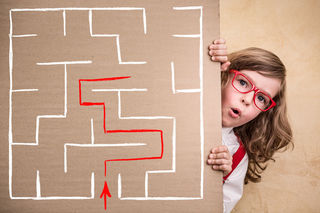Motivation
"It's So Hard to Watch My Kid Struggle." Here's How to Help.
If your child's challenges stand in the way of his goals, teach him this skill.
Posted August 22, 2019
It’s so sad to watch AJ struggle! It feels like there’s this race – every other kid in the world started at the same line, but AJ has to walk a few miles just to get to the starting line. He’s only ten, and already has been diagnosed with social anxiety disorder and depression. Just getting him out in the morning feels like a marathon. If I’m wrung out and exhausted, how do you think he feels? Deborah sighs and takes a sip of her (clearly badly needed) coffee. It’s like he has obstacles and roadblocks at every turn.
Yesterday, he was invited to a birthday party. He woke up all excited and said “I’m going to talk to people there, Mom, I really will.” I came to pick him up and the sight broke my heart. There’s AJ, sitting on the porch swing, reading. All the other kids are on the trampoline with toy lightsabers, having a ball.
There’s a line from Dialectical Behavior Therapy that has always resonated with me – “It’s not your fault, but it is your problem.” It’s not AJ’s fault that he was born predisposed to social anxiety and depression. It’s not Deborah’s fault either (except in the sense that she contributed at least 50% of his genes, but it’s not like she was able to pick and choose which ones!)
In the TARGET System (read more about the TARGET System here), the “G” stands for Goal Directed Behavior. If you think about it, no matter what our children’s challenges, they stand in the way of getting to their goals. We have to ask ourselves two related questions:
- Why does my child act this way?
- What should I do about it?
Why Does My Child Act This Way?
The first three letters of TARGET, T-A-R are the “Whys.”
- Theory - Why do my interactions with my child feel chaotic? A unified parenting theory can help. (Read more about creating a unified parenting theory here.)
- Antecedent Analysis: Why does my child explode or implode? We need to Analyze Antecedents to figure out the triggers. (Read more about Analyzing Antecedents here.)
- Rewards and Reinforcers: Why is it so hard to change my child’s behavior? We need to set up the proper Rewards and Reinforcers. (Read more about the difference between rewards and bribes here.)
What Should I Do About It?
The second half of the word TARGET are what I like to call the GET strategies. They are what we parents “get” out of targeting our parenting to our children’s challenges. GET stands for Goal Directed Behavior, Educate for Effectiveness, and Train It In.
Goal-Directed Behavior and Challenging Children:
Here are the kinds of things I hear as a clinical child psychologist:
"I wanted to talk to people at the party – but social anxiety stood in my way."
"I wanted to have a great day in my classroom and earn points on my chart, but anger got in my way."
"I wanted to get a good mark on my test, but ADHD didn’t let me get there. I wanted to handle life in a dorm as a freshman, but the trauma in my past got in my way."

In every case, there’s a goal, and an obstacle that prevents our Challenging Children from getting there. It doesn’t seem fair because it isn’t. But that doesn’t mean we can’t help our children anyway.
Research shows that parenting style is a strong mediator of “effortful control.” Effortful control is the skill you need to pay attention to a longer-term goal, rather than give in to immediate gratification.
The famous “Marshmallow” studies conducted by Walter Mischel have been analyzed to death in the popular press. Here’s a take on them we don’t always think of. Mischel set up a challenge for children – he said “Here’s a marshmallow. If you can wait for a few minutes, and not eat the marshmallow, then you can have two marshmallows.” Two marshmallows are better than one, right? The children who were able to delay gratification and wait for the second marshmallow were followed through life and found to have better outcomes on many measures.
Challenging Children often have trouble with effortful control because of their unique neurology and their obstacles. They are set up to fail the marshmallow test, every time! It’s our job to teach them this concept directly, and incrementally. One thing we have to always keep in mind is to constantly refer back to the skill of “goal-directed behavior.”
Using Challenges To Teach Goal-Directed Behavior:
For example, if a child is struggling to attend a party and socialize, we can draw a simple “CandyLand” style board, with steps written on it.
- Saying “I’m willing to go to a party.
- Buying a gift for the party host.
- Thinking about “people I already know at the party, who I feel less worried about talking to.”
- Rating those people on a scale from 1-10, with 1 being “really easy to talk to, like my first cousin” and 10 being “I don’t know this person at all, challenging to talk to.”
- Having mock conversations at home with mom pretending to be a fellow party guest (Mom, get into it – dress up like a kid and make it seem real!)
- Practicing my self-regulation skills, like deep breathing and progressive muscle relaxation, a few times a day, to get my body used to it.
- Getting into the car.
- Getting OUT of the car!
- Walking into the party.
- Talking to people at the party.
If AJ and his mom look at their CandyLand board, we can see that they got 90% of the way there. AJ got all the way to the last square. He was actually quite goal directed. Mom needs to reframe this as a journey that was 90% completed, because AJ stuck to his goal.
Turning Rewards Into a Goal Directed Behavior Mindset:
Remember that when we’re rewarding a child for completing any behavioral goal, we don’t just want to give the child a reward. We want to make the reward much bigger. We want to say things like “This isn’t just a bike! This is a bike that proves that you are a kid who can achieve a goal! Every time you ride this bike, I want you to say to yourself “I’m someone who can achieve my goals!”
Now that’s what I call rewarding!
© Robyn Koslowitz, 2019
References
Spindrad,T. L., Eisenberg, N., Gaertner, B., Popp, T., Smith, C. L., Kupfer, A., et al. (2007). Relations of maternal socialization and toddlers’ effortful control to children’s adjustment and social competence. Developmental Psychology, 43, 1170–1186
Mischel, W. (2014). The Marshmallow Test: Mastering self-control. New York, NY, US: Little, Brown and Co.
Linehan, M. M. (2015). DBT® skills training manual (2nd ed.). New York, NY, US: Guilford Press.




